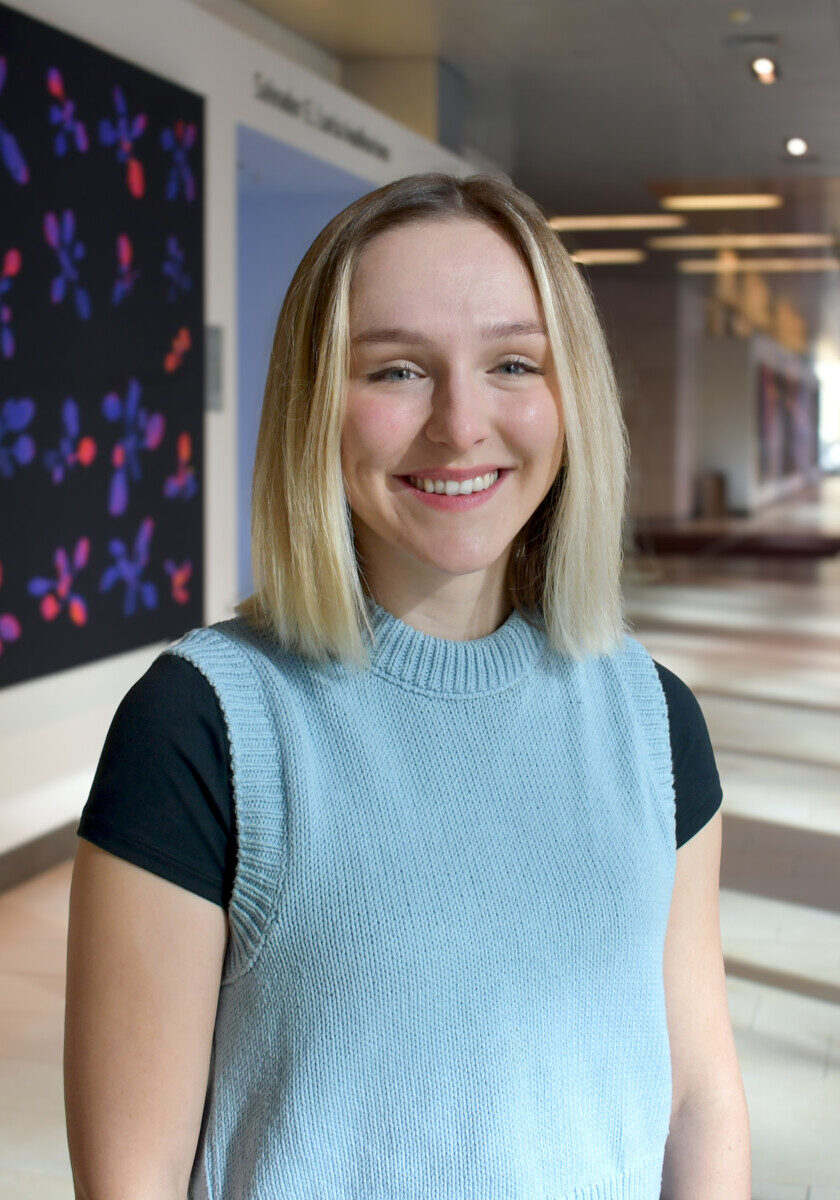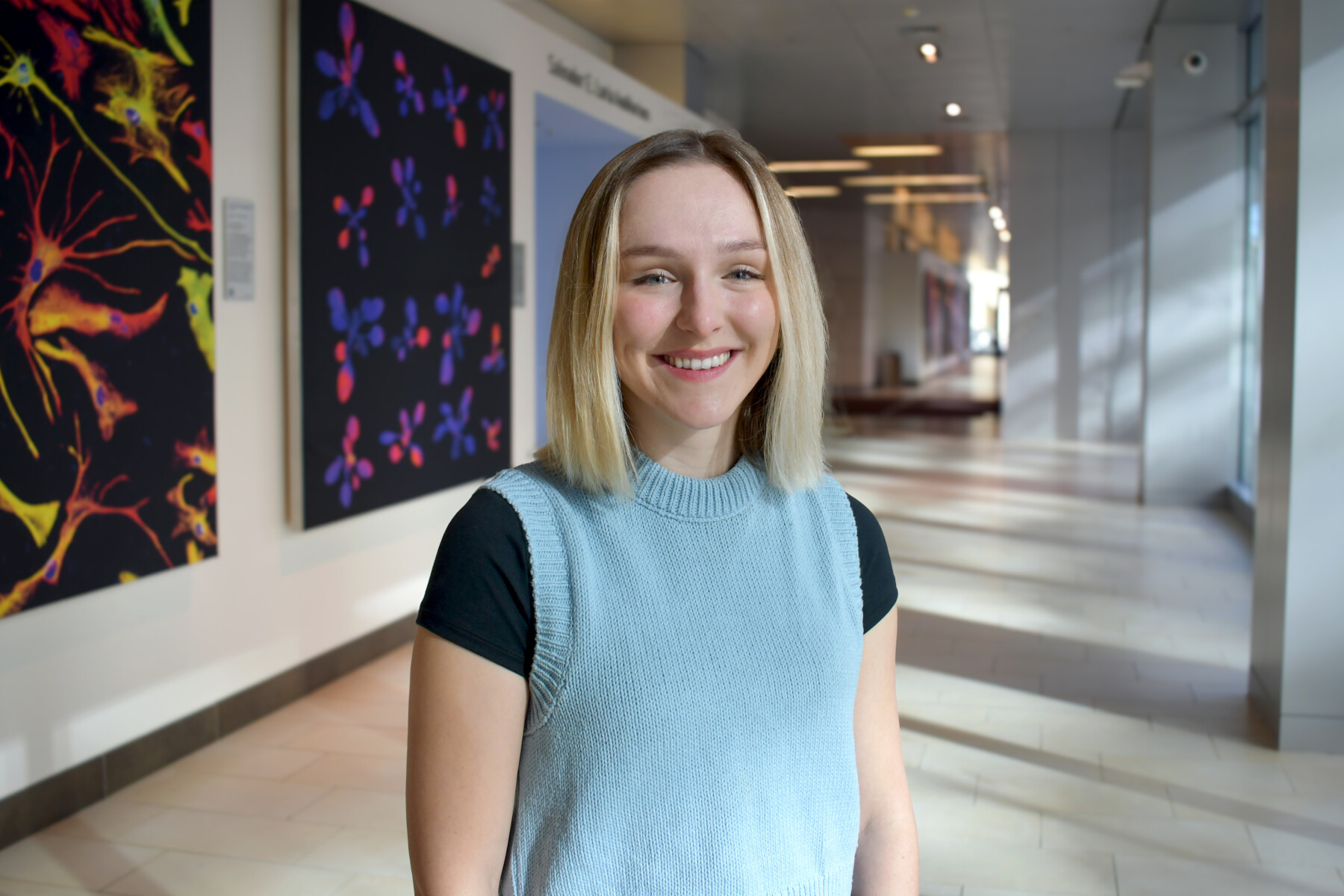Congratulations to the TBBCF 2025 Grant Recipients
After reviewing dozens of grant proposals, our TBBCF Scientific Advisory Board has awarded fellowships to the following top 2025 researchers.
Click here to read about this year's grant recipients and their research.
The Terri Brodeur Breast Cancer Foundation Granting Process
Download a PDF of The Terri Brodeur Breast Cancer Foundation (TBBCF) 2026 Granting Process
Scientific Advisory Board Members
Nicholas Saccomano, PhD
Chair – Former Chief Scientific Officer, Senior VP, Pfizer Boulder Research and Development
John LaMattina, PhD
Co-Chair – Former President, Pfizer Global Research and Development
Michael Garabedian, PhD
Professor and Course Director, New York University Medical Center
Susan Logan, PhD
Associate Professor, New York University Medical Center
Michael Morin, PhD
President and Chief Scientific Officer Immunome
TBBCF Research Grant Recipients
Publications
Discover publications recognizing the support from the Terri Brodeur Breast Cancer Foundation by clicking here.
Abstracts – 2007-2023
Explore the fascinating grant recipient abstracts from 2007 to 2023! Click here to discover the groundbreaking work of our researchers.
2025
Genevra Kuziel, PhD
Dana-Farber Cancer Institute
Megan J. Priestley, PhD
MIT - Koch Institute for Integrative Cancer Research
Benjamin Schrank, MD, PhD
MD Anderson Cancer Center
Sherry Shen, MD
Memorial Sloan Kettering Cancer Center
2024
Julia D Ransohoff MD
Stanford University - School of Med.
Paolo Tarantino
Dana-Farber Cancer Institute
Sam Kleeman, MD, PhD
Cold Spring Harbor Laboratory
2023
Bruno Barufaldi, PhD
University of Pennsylvania
Marla Lipsyc-Sharf, MD
Dana-Farber Cancer Institute
Megan Tesch, MD
Dana-Farber Cancer Institute
Marie Will, MD, PhD
Memorial Sloan Kettering Cancer Center
Bogan Wu, PhD
Massachusetts General Hospital
2022
Emanuela Ferraro, MD
Memorial Sloan Kettering Cancer Center
Amy Schade, PhD
Brigham & Women's Hospital - Harvard Medical School
Sirinapa Sribenja, PhD
Roswell Park Comprehensive Cancer Center
2021
Daniel L. Abravanel, MD, PhD
Dana-Farber Cancer Institute – Harvard Medical School
Douglas Micalizzi MD, PhD
Massachusetts General Hospital – Harvard Medical School
Rachna Malani, MD
Memorial Sloan Kettering Cancer Center
Jennifer Rosenbluth, MD, PhD
Dana-Farber Cancer Institute – Harvard Medical School
2020
Jennifer L. Guerriero, PhD
Dana-Farber Cancer Institute – Harvard Medical School
Sheheryar K. Kabraji, BM BCh
Dana-Farber Cancer Institute – Harvard Medical School
Naiara Perurena, PhD, PharmD
Brigham and Women’s Hospital – Harvard Medical School
Jan Remsik, PhD, PharmD
Memorial Sloan Kettering Cancer Center
2019
Ana Garrido-Castro, MD
Dana-Farber Cancer Institute
Veerle Daniels, PhD
Dana-Farber Cancer Institute
Jing Hu, PhD
Memorial Sloan Kettering Cancer Center
Laura Spring, MD
Massachusetts General Hospital
2018
Arko Dasgupta, PhD
Fred Hutchinson Cancer Research Center
Sheng Sun, PhD
Massachusetts General Hospital Cancer Center
Adrienne Gropper Waks, MD
Dana-Farber Cancer Institute
2017
Li, Ji, PhD
Dana-Farber Cancer Institute
Meyer, Aaron, PhD
Koch Institute for Integrative Cancer Research at Massachusetts Institute of Technology
Parsons, Heather, PhD
Dana-Farber Cancer Institute
2016
Albrengues, Jean, PhD
Cold Spring Harbor Laboratory
Karaayvaz, Mihriban, PhD
Mass General Hospital Cancer Center
Stover, Daniel, MD
Dana-Farber Cancer Institute
Toska, Eneda, PhD
Memorial Sloan Kettering
2015
Dhimolea, Eugen, PhD
Dana-Farber Cancer Institute
Ilic, Nina, PhD
Dana-Farber Cancer Institute
Pavlova, Natasha, PhD
Memorial Sloan Kettering
2014
Carmona, Javier PhD
Memorial Sloan Kettering
Hofstatter, Erin MD
Smilow Cancer Hospital at Yale New Haven
Page, David MD
Memorial Sloan Kettering
2013
Vora, Sadhna R. MD
Dana-Farber Cancer Institute
Anczukow, Olga, PhD
Cold Spring Harbor Laboratory
Rossetti, Stefano PhD
Roswell Park Alliance Foundation
2012
Diab, Adi MD
Memorial Sloan Kettering
Jhaveri, Komal, MD
NYU School of Medicine
Brastianos, Priscilla MD
Dana-Farber Cancer Institute
2011
Gucalp, Ayca MD
Memorial Sloan Kettering
Walczak, Maciej MD
Memorial Sloan Kettering
Li, Yang PhD
Dana-Farber Cancer Institute
2010
Gajria, Devika MD
Memorial Sloan Kettering
Kass, Elizabeth MD
Memorial Sloan Kettering
Zhou, Penghui MD
Dana-Farber Cancer Institute
Kochupurakkal, Bose PhD
Dana-Farber Cancer Institute
2009
Bialucha, Carl Uli PhD
Cold Spring Harbor Laboratory
Kutuk, Ozgur MD, PhD
Dana-Farber Cancer Institute
Bailey, Shannon T. MD
Dana-Farber Cancer Institute
Zhang, Qing PhD
Dana-Farber Cancer Institute
2008
Irie, Hanna Y MD, PhD
Mount Sinai School of Medicine
Choudhury, Sibgat PhD
Dana-Farber Cancer Institute
Fertuck, Kirsten PhD
Dana-Farber Cancer Institute
2007
Oliver, Aundrea MD
Dana-Farber Cancer Institute
Chatterjee, Samit PhD
Cold Spring Harbor Laboratory
Mayer, Erica MD, MPH
Dana-Farber Cancer Institute
Lee, Dongjoo PhD
Memorial Sloan Kettering
LOOKING TO MAKE A DONATION?
Join Our Email List
Get the latest news and updates from the foundation directly to your inbox.




 Description of work: Breast cancer is the second most common cancer diagnosed worldwide. In the United States alone, there are 260,000 new diagnoses and 40,000 deaths from breast cancer each year. The survival of patients is highly related to the cancer stage. More recently, early-stage breast cancer has been treated with chemotherapy before surgery, which allows oncologists to assess the response of the cancer to chemotherapy. A good response to initial chemotherapy is associated with patients living longer and a higher chance of cure. In contrast, a poorer response is associated with cancer recurrence and shorter survival. It is therefore important to accurately measure the presence or absence of residual cancer after initial chemotherapy, at the time of surgery--since this is when decisions are made to escalate treatment or to consider a patient cured.
Description of work: Breast cancer is the second most common cancer diagnosed worldwide. In the United States alone, there are 260,000 new diagnoses and 40,000 deaths from breast cancer each year. The survival of patients is highly related to the cancer stage. More recently, early-stage breast cancer has been treated with chemotherapy before surgery, which allows oncologists to assess the response of the cancer to chemotherapy. A good response to initial chemotherapy is associated with patients living longer and a higher chance of cure. In contrast, a poorer response is associated with cancer recurrence and shorter survival. It is therefore important to accurately measure the presence or absence of residual cancer after initial chemotherapy, at the time of surgery--since this is when decisions are made to escalate treatment or to consider a patient cured. The optimization of systemic therapy for young women with early-stage hormone receptor-positive (HR+)/HER2-negative remains a significant challenge, particularly in terms of predicting chemotherapy responsiveness. This is exemplified by recent gene expression profile-driven adjuvant therapy trials, in which premenopausal patients with low-to-intermediate genomic risk HR+ tumors derived a survival advantage from chemotherapy, but not their postmenopausal counterparts. Critical questions have arisen as to whether this chemotherapy benefit stems from induction of ovarian function suppression, with consequent downregulation of estrogen receptor activity, or whether there are intrinsic differences in the biology of young women’s tumors, particularly tumor-immune microenvironment, that render them more susceptible to the cytotoxic effects of chemotherapy. Systemic therapy strategies for young women with HR+ breast cancer could differ considerably on the basis of these alternative hypotheses, ranging from chemotherapy-sparing/hormonal-based approaches to escalated chemotherapy regimens incorporating agents such as immune checkpoint inhibitors.The objective of this project is to determine the impact of chemotherapy on estrogen receptor activity and tumor-immune microenvironment in young women with HR+ breast cancer, by examining changes in the expression of pertinent genes in response to chemotherapy. In doing so, this project aims to elucidate key mechanisms by which chemotherapy exerts a differential benefit in young women with HR+ breast cancer. Tumor specimens will be derived from a prospective multicenter cohort study of women diagnosed with breast cancer at age 40 years or younger, enabling correlation of chemotherapy-mediated estrogen receptor- and immune-related gene expression changes with patient characteristics, treatment response, and survival outcomes. This will help to establish the clinical significance of these chemotherapeutic effects in young women with HR+ breast cancer, and accordingly, could provide a strong rationale for future tumor biology-guided clinical trials within this disparate population in need of more tailored systemic therapy options.
The optimization of systemic therapy for young women with early-stage hormone receptor-positive (HR+)/HER2-negative remains a significant challenge, particularly in terms of predicting chemotherapy responsiveness. This is exemplified by recent gene expression profile-driven adjuvant therapy trials, in which premenopausal patients with low-to-intermediate genomic risk HR+ tumors derived a survival advantage from chemotherapy, but not their postmenopausal counterparts. Critical questions have arisen as to whether this chemotherapy benefit stems from induction of ovarian function suppression, with consequent downregulation of estrogen receptor activity, or whether there are intrinsic differences in the biology of young women’s tumors, particularly tumor-immune microenvironment, that render them more susceptible to the cytotoxic effects of chemotherapy. Systemic therapy strategies for young women with HR+ breast cancer could differ considerably on the basis of these alternative hypotheses, ranging from chemotherapy-sparing/hormonal-based approaches to escalated chemotherapy regimens incorporating agents such as immune checkpoint inhibitors.The objective of this project is to determine the impact of chemotherapy on estrogen receptor activity and tumor-immune microenvironment in young women with HR+ breast cancer, by examining changes in the expression of pertinent genes in response to chemotherapy. In doing so, this project aims to elucidate key mechanisms by which chemotherapy exerts a differential benefit in young women with HR+ breast cancer. Tumor specimens will be derived from a prospective multicenter cohort study of women diagnosed with breast cancer at age 40 years or younger, enabling correlation of chemotherapy-mediated estrogen receptor- and immune-related gene expression changes with patient characteristics, treatment response, and survival outcomes. This will help to establish the clinical significance of these chemotherapeutic effects in young women with HR+ breast cancer, and accordingly, could provide a strong rationale for future tumor biology-guided clinical trials within this disparate population in need of more tailored systemic therapy options. Breast cancer presents as several clinical subtypes that have different progression trajectories and disparate prognoses. However, there are two primary etiologic subtypes, each associated with a distinct set of risk factors and genetic profiles that essentially correspond to estrogen receptor-positive (ER+) and negative (ER-) disease, and the ER status serves as an important marker for treatment options and prognosis in breast cancer patients. Compared with women diagnosed with ER+ breast cancer, those with ER- tumors generally have a poorer prognosis, partly because of their aggressive phenotype and the lack of targeted therapy. In addition, high-grade ER- breast cancer is more common among American women of African ancestry (AA) than among those of European ancestry (EA). Presently, the underlying causes of this increased risk of ER breast cancer in AA women are not clear, but the causes are likely multifaceted. In the last few decades, substantial research has been devoted to identifying epigenetic and transcriptomic alterations that drive tumorigenesis. These efforts have led to an improved understanding of its mechanisms and advanced methods for targeted therapeutic strategies for cancer and its complications. However, evidence linking RNA modifications to the development, maintenance, and progression of breast cancer is still lacking. By using my expertise in molecular and cellular biology and by taking advantage of novel, state-of-the-art high-throughput techniques in m6A Selective Allyl Chemical labeling and sequencing (m6A-SAC-seq) and CRISPR/Cas technology, I want to elucidate the mechanisms of action of epi transcriptomic differences in tumor progression between ER- and ER+ breast cancers and link those differences to clinical outcome disparities between women of difference races. Through this work, we have identified more than 150 candidate mRNAs that show significant differences in m6A methylation between ER subtypes and races. I now propose to test a select group of these modifications for their effects on breast cancer progression by manipulating the fraction of m6A methylation in breast cancer cell lines using CRISPR/Cas technology. I will also identify the functional roles of m6A RNA modifications in breast cancer cells. As an active member of the methylation research group at Roswell Park Comprehensive Cancer Center, and as a Research Associate participating in National Institutes of Health (NIH) R01 funded studies on DNA methylation profiling of breast tumors from AA and EA women as well as a currently funded R01 to study long noncoding RNAs (lncRNAs) in the same patient cohorts, I have developed a strong passion for research in the field of epigenetic regulation of cancer. I will strive to become an independent investigator who conducts top-notch epigenetic research that will ultimately influence patient care. My overall long-term goal as an independent investigator is to decipher the cellular and molecular phenomena that occur in breast cancer to understand breast cancer better and potentially facilitate the development of novel molecular targets for treatment and cancer prevention. Dr. Sribenja completed her undergraduate
Breast cancer presents as several clinical subtypes that have different progression trajectories and disparate prognoses. However, there are two primary etiologic subtypes, each associated with a distinct set of risk factors and genetic profiles that essentially correspond to estrogen receptor-positive (ER+) and negative (ER-) disease, and the ER status serves as an important marker for treatment options and prognosis in breast cancer patients. Compared with women diagnosed with ER+ breast cancer, those with ER- tumors generally have a poorer prognosis, partly because of their aggressive phenotype and the lack of targeted therapy. In addition, high-grade ER- breast cancer is more common among American women of African ancestry (AA) than among those of European ancestry (EA). Presently, the underlying causes of this increased risk of ER breast cancer in AA women are not clear, but the causes are likely multifaceted. In the last few decades, substantial research has been devoted to identifying epigenetic and transcriptomic alterations that drive tumorigenesis. These efforts have led to an improved understanding of its mechanisms and advanced methods for targeted therapeutic strategies for cancer and its complications. However, evidence linking RNA modifications to the development, maintenance, and progression of breast cancer is still lacking. By using my expertise in molecular and cellular biology and by taking advantage of novel, state-of-the-art high-throughput techniques in m6A Selective Allyl Chemical labeling and sequencing (m6A-SAC-seq) and CRISPR/Cas technology, I want to elucidate the mechanisms of action of epi transcriptomic differences in tumor progression between ER- and ER+ breast cancers and link those differences to clinical outcome disparities between women of difference races. Through this work, we have identified more than 150 candidate mRNAs that show significant differences in m6A methylation between ER subtypes and races. I now propose to test a select group of these modifications for their effects on breast cancer progression by manipulating the fraction of m6A methylation in breast cancer cell lines using CRISPR/Cas technology. I will also identify the functional roles of m6A RNA modifications in breast cancer cells. As an active member of the methylation research group at Roswell Park Comprehensive Cancer Center, and as a Research Associate participating in National Institutes of Health (NIH) R01 funded studies on DNA methylation profiling of breast tumors from AA and EA women as well as a currently funded R01 to study long noncoding RNAs (lncRNAs) in the same patient cohorts, I have developed a strong passion for research in the field of epigenetic regulation of cancer. I will strive to become an independent investigator who conducts top-notch epigenetic research that will ultimately influence patient care. My overall long-term goal as an independent investigator is to decipher the cellular and molecular phenomena that occur in breast cancer to understand breast cancer better and potentially facilitate the development of novel molecular targets for treatment and cancer prevention. Dr. Sribenja completed her undergraduate Modulating the immune system as an anti-cancer strategy has shown great promise in some types of cancer, however there has been limited responses in breast cancer. While the main focus of immunotherapy has been on the adaptive immune system, namely T cells, harnessing innate immune cells such as tumor-associated macrophages (TAMs) offers a novel strategy to induce breast tumor regression. Breast tumors are highly infiltrated with suppressive TAMs and clinically, a high number of TAMs in breast tumors correlate with a worse overall prognosis and increased metastasis. Therefore, the proposed research focuses on understanding how TAMs contribute to the suppressive tumor microenvironment. A major goal of the project funded through the Terri Brodeur Breast Cancer Foundation is to reveal novel signaling pathways in TAMs that can be targeted therapeutically. The unique and novel clinical focus of harnessing macrophages has the potential to have a considerable impact in the treatment of breast cancer. Dr. Guerriero received her bachelor’s degree in Biochemistry from Northeastern University and has a PhD in Molecular and Cellular Biology and Immunology and Pathology from Stony Brook University where she trained under Dr. Wei-Xing Zong and completed her thesis entitled, “A study of cell death pathways and innate immunity in cancer chemotherapy”. Dr. Guerriero completed her postdoctoral training in the laboratory of Dr. Anthony Letai at Dana-Farber Cancer Institute where she investigated the role of tumor macrophages in breast cancer and identified novel mechanisms to target pro-tumor macrophages to an anti-tumor phenotype to induce tumor regression. Dr. Guerriero is now an Instructor in Medicine at Harvard Medical School and is the Director of the Breast Tumor Immunology Laboratory at Dana-Farber Cancer-Institute. Her main focus is to bridge basic and translational breast cancer research and immunology with clinical science. She focuses on translating basic knowledge of how macrophages in the breast tumor microenvironment induce apoptosis of cancer cells, as well as identify how macrophages regulate their phenotype at a molecular level. A major goal is to harnessing the anti-tumor potential of tumor-associated macrophages for anti-cancer therapy in breast cancer.
Modulating the immune system as an anti-cancer strategy has shown great promise in some types of cancer, however there has been limited responses in breast cancer. While the main focus of immunotherapy has been on the adaptive immune system, namely T cells, harnessing innate immune cells such as tumor-associated macrophages (TAMs) offers a novel strategy to induce breast tumor regression. Breast tumors are highly infiltrated with suppressive TAMs and clinically, a high number of TAMs in breast tumors correlate with a worse overall prognosis and increased metastasis. Therefore, the proposed research focuses on understanding how TAMs contribute to the suppressive tumor microenvironment. A major goal of the project funded through the Terri Brodeur Breast Cancer Foundation is to reveal novel signaling pathways in TAMs that can be targeted therapeutically. The unique and novel clinical focus of harnessing macrophages has the potential to have a considerable impact in the treatment of breast cancer. Dr. Guerriero received her bachelor’s degree in Biochemistry from Northeastern University and has a PhD in Molecular and Cellular Biology and Immunology and Pathology from Stony Brook University where she trained under Dr. Wei-Xing Zong and completed her thesis entitled, “A study of cell death pathways and innate immunity in cancer chemotherapy”. Dr. Guerriero completed her postdoctoral training in the laboratory of Dr. Anthony Letai at Dana-Farber Cancer Institute where she investigated the role of tumor macrophages in breast cancer and identified novel mechanisms to target pro-tumor macrophages to an anti-tumor phenotype to induce tumor regression. Dr. Guerriero is now an Instructor in Medicine at Harvard Medical School and is the Director of the Breast Tumor Immunology Laboratory at Dana-Farber Cancer-Institute. Her main focus is to bridge basic and translational breast cancer research and immunology with clinical science. She focuses on translating basic knowledge of how macrophages in the breast tumor microenvironment induce apoptosis of cancer cells, as well as identify how macrophages regulate their phenotype at a molecular level. A major goal is to harnessing the anti-tumor potential of tumor-associated macrophages for anti-cancer therapy in breast cancer.

 Short Abstract/Biography:
Short Abstract/Biography: Genomic studies of breast cancer have dramatically transformed the field over the last few decades. Key oncogenic drivers identified in these studies have not only shed light on breast cancer biology but also paved the way for clinical tumor profiling and targeted therapy. Several recent large-scale analyses have identified GATA3 as one of the most commonly mutated genes in breast cancer; however, little is known about the mechanism by which GATA3 mutations modify breast cancer phenotypes. This represents a major gap in our scientific understanding of the disease and missed opportunities for targeted therapeutics in patients with these mutations. GATA3 has long been known as a critical factor in mammary development, where it is required for the activation and maintenance of the mammary luminal differentiation program. In addition, GATA3 regulates estrogen receptor (ER) signaling and is crucial in the biology of ER+ breast cancer. We hypothesize that (1) GATA3 mutations modify breast cancer phenotypes by directing lineage transitions and modulating the ER transcriptome, and that (2) these modifications have important ramifications for breast tumor biology and therapy. Studies of breast cancer drivers thus far have largely focused on oncogenes or tumor suppressors with well-defined downstream substrates, such as kinases and phosphatases.
Genomic studies of breast cancer have dramatically transformed the field over the last few decades. Key oncogenic drivers identified in these studies have not only shed light on breast cancer biology but also paved the way for clinical tumor profiling and targeted therapy. Several recent large-scale analyses have identified GATA3 as one of the most commonly mutated genes in breast cancer; however, little is known about the mechanism by which GATA3 mutations modify breast cancer phenotypes. This represents a major gap in our scientific understanding of the disease and missed opportunities for targeted therapeutics in patients with these mutations. GATA3 has long been known as a critical factor in mammary development, where it is required for the activation and maintenance of the mammary luminal differentiation program. In addition, GATA3 regulates estrogen receptor (ER) signaling and is crucial in the biology of ER+ breast cancer. We hypothesize that (1) GATA3 mutations modify breast cancer phenotypes by directing lineage transitions and modulating the ER transcriptome, and that (2) these modifications have important ramifications for breast tumor biology and therapy. Studies of breast cancer drivers thus far have largely focused on oncogenes or tumor suppressors with well-defined downstream substrates, such as kinases and phosphatases.
 While effective HER2-targeting drugs have greatly improved outcomes for patients with HER2-positive (HER2+) breast cancer, relapse and recurrence still occur. When HER2+ breast cancer returns after treatment, it is because some cancer cells survive killing, and are known as minimal residual disease (MRD). To study the biology of MRD we have developed a mouse model of HER2+ breast cancer (t-HER2) where we can turn on and turn off tumor formation at will. This model also has an intact immune system, making it ideal to study tumor-immune interactions. When we turn off tumors, we model the scenario in patients where tumors shrink with effective therapy. However, like in some patients, tumors recur spontaneously in our model. Using the t-HER2 model we found that MRD is comprised of rare ‘sleeping’, or quiescent, cancer cells surrounded by signs of a suppressed anti-tumor immune response. We hypothesize that MRD after anti-HER2 treatment occurs because drug-resistant quiescent cancer cells dampen the anti-tumor response. Our objective is to eliminate MRD after HER2 therapy by stimulating an anti-tumor immune response. To achieve this goal, we will first investigate the immune changes seen when tumors shrink to MRD in the t-HER2 model. Next, we will study how the AKTlow quiescent cancer cell (QCC) suppresses the anti-tumor immune response in the setting of MRD. Finally, we will test whether using immunotherapy can prevent tumors from recurring after they shrink with HER2 inhibition. This study will suggest new ways to identify patients at risk for MRD and help understand how rare, quiescent cancer cells contribute to tumor drug-resistance. Our results could be readily translated into a novel clinical trial using a QCC-targeting drug + immunotherapy to prevent relapse and recurrence in patients with HER2+ breast cancer.
While effective HER2-targeting drugs have greatly improved outcomes for patients with HER2-positive (HER2+) breast cancer, relapse and recurrence still occur. When HER2+ breast cancer returns after treatment, it is because some cancer cells survive killing, and are known as minimal residual disease (MRD). To study the biology of MRD we have developed a mouse model of HER2+ breast cancer (t-HER2) where we can turn on and turn off tumor formation at will. This model also has an intact immune system, making it ideal to study tumor-immune interactions. When we turn off tumors, we model the scenario in patients where tumors shrink with effective therapy. However, like in some patients, tumors recur spontaneously in our model. Using the t-HER2 model we found that MRD is comprised of rare ‘sleeping’, or quiescent, cancer cells surrounded by signs of a suppressed anti-tumor immune response. We hypothesize that MRD after anti-HER2 treatment occurs because drug-resistant quiescent cancer cells dampen the anti-tumor response. Our objective is to eliminate MRD after HER2 therapy by stimulating an anti-tumor immune response. To achieve this goal, we will first investigate the immune changes seen when tumors shrink to MRD in the t-HER2 model. Next, we will study how the AKTlow quiescent cancer cell (QCC) suppresses the anti-tumor immune response in the setting of MRD. Finally, we will test whether using immunotherapy can prevent tumors from recurring after they shrink with HER2 inhibition. This study will suggest new ways to identify patients at risk for MRD and help understand how rare, quiescent cancer cells contribute to tumor drug-resistance. Our results could be readily translated into a novel clinical trial using a QCC-targeting drug + immunotherapy to prevent relapse and recurrence in patients with HER2+ breast cancer.

 Summary: Triple-negative breast cancer (TNBC) is a particularly aggressive type of breast cancer. TNBC does not have the three receptor types commonly present in breast cancer cells. This means that the most common drugs used to treat breast cancer are not effective. The lack of targeted treatments for TNBC makes the disease much more likely to spread and recur. There is an urgent need to develop new, effective therapies for this type of breast cancer. Previous research has shown that TNBC tumors have a high level of a protein normally found on nerve cells in the brain called NMDA receptors. Some patients, including patients with breast cancer, naturally develop antibodies that target NMDA receptors. In these patients, these anti-NMDA receptor antibodies can kill cancer cells. However, in some patients, the antibodies can cause inflammation in the brain, known as encephalitis. Symptoms of encephalitis can include changes in mood, hallucinations, memory loss and seizures. The goal of Dr. Kleeman’s project is to create a safe and effective treatment for TNBC by finding antibodies that can target NMDA receptors on cancer cells without causing damage to the nervous system. The project involves several steps. First, Dr. Kleeman will make a mouse model of TNBC with NMDA receptors on the surface of cancer cells. Then, he will use this mouse model to find antibodies that can bind to NMDA receptors. Cryogenic electron microscopy (cryo-EM) is a type of electron microscopy that can be used to obtain images of proteins. Dr. Kleeman will use cryo-EM to study how the mouse antibodies bind to NMDA receptors. The idea is to find antibodies that bind to NMDA receptors without causing changes to the NMDA receptor structure that could result in encephalitis. Finally, he will use the new antibodies to treat mice with TNBC and to determine if they should potentially be tested in patients with TNBC. Overall, Dr. Kleeman’s project hopes to show that anti-NMDA receptor antibodies can be used as a new treatment for the 40,000 patients diagnosed with TNBC in the USA every year.
Summary: Triple-negative breast cancer (TNBC) is a particularly aggressive type of breast cancer. TNBC does not have the three receptor types commonly present in breast cancer cells. This means that the most common drugs used to treat breast cancer are not effective. The lack of targeted treatments for TNBC makes the disease much more likely to spread and recur. There is an urgent need to develop new, effective therapies for this type of breast cancer. Previous research has shown that TNBC tumors have a high level of a protein normally found on nerve cells in the brain called NMDA receptors. Some patients, including patients with breast cancer, naturally develop antibodies that target NMDA receptors. In these patients, these anti-NMDA receptor antibodies can kill cancer cells. However, in some patients, the antibodies can cause inflammation in the brain, known as encephalitis. Symptoms of encephalitis can include changes in mood, hallucinations, memory loss and seizures. The goal of Dr. Kleeman’s project is to create a safe and effective treatment for TNBC by finding antibodies that can target NMDA receptors on cancer cells without causing damage to the nervous system. The project involves several steps. First, Dr. Kleeman will make a mouse model of TNBC with NMDA receptors on the surface of cancer cells. Then, he will use this mouse model to find antibodies that can bind to NMDA receptors. Cryogenic electron microscopy (cryo-EM) is a type of electron microscopy that can be used to obtain images of proteins. Dr. Kleeman will use cryo-EM to study how the mouse antibodies bind to NMDA receptors. The idea is to find antibodies that bind to NMDA receptors without causing changes to the NMDA receptor structure that could result in encephalitis. Finally, he will use the new antibodies to treat mice with TNBC and to determine if they should potentially be tested in patients with TNBC. Overall, Dr. Kleeman’s project hopes to show that anti-NMDA receptor antibodies can be used as a new treatment for the 40,000 patients diagnosed with TNBC in the USA every year. Triple-negative breast cancer (TNBC) accounts for 10% to 20% of all breast cancers and is associated with the worst prognosis among all breast cancer subtypes. TNBC is characterized by a limited response to standard chemotherapy and few options for targeted therapies and, therefore, represents a major unmet clinical need. While the immune system plays an important role in fighting cancer and in response to anticancer treatment, TNBCs are often “immune-cold”, characterized as lack of immune cell infiltration. Understanding the immune-suppressive mechanisms of TNBCs and developing conceptually new therapeutic approaches will be essential to providing patients with more effective therapies that impact survival. In preliminary studies, Dr. Wu has identified a previously unappreciated mechanism of immune evasion utilized by TNBC.
Triple-negative breast cancer (TNBC) accounts for 10% to 20% of all breast cancers and is associated with the worst prognosis among all breast cancer subtypes. TNBC is characterized by a limited response to standard chemotherapy and few options for targeted therapies and, therefore, represents a major unmet clinical need. While the immune system plays an important role in fighting cancer and in response to anticancer treatment, TNBCs are often “immune-cold”, characterized as lack of immune cell infiltration. Understanding the immune-suppressive mechanisms of TNBCs and developing conceptually new therapeutic approaches will be essential to providing patients with more effective therapies that impact survival. In preliminary studies, Dr. Wu has identified a previously unappreciated mechanism of immune evasion utilized by TNBC. Circulating tumor cells (CTCs) are cells that are derived from a tumor but are isolated from the blood of cancer patients. Only recently have technological advances permitted the isolation and characterization of these rare cells. CTCs offer a snapshot of the invasive cancer cells that give rise to metastatic lesions and are an important model for studying cancer and the stages of metastasis. The study of CTCs and the mechanisms of metastasis has the potential to catalyze the development of new treatments for breast cancer that more effectively target CTCs and prevent or suppress the development of metastasis. To investigate breast cancer CTCs and metastasis, I have generated a mouse model of breast cancer metastasis and performed a screen to identify regulators of metastasis. From this screen, I identified RPL15, an integral component of the ribosome, for further investigation. I have shown that increased levels of the RPL15 enhance breast cancer spread in mice.
Circulating tumor cells (CTCs) are cells that are derived from a tumor but are isolated from the blood of cancer patients. Only recently have technological advances permitted the isolation and characterization of these rare cells. CTCs offer a snapshot of the invasive cancer cells that give rise to metastatic lesions and are an important model for studying cancer and the stages of metastasis. The study of CTCs and the mechanisms of metastasis has the potential to catalyze the development of new treatments for breast cancer that more effectively target CTCs and prevent or suppress the development of metastasis. To investigate breast cancer CTCs and metastasis, I have generated a mouse model of breast cancer metastasis and performed a screen to identify regulators of metastasis. From this screen, I identified RPL15, an integral component of the ribosome, for further investigation. I have shown that increased levels of the RPL15 enhance breast cancer spread in mice. Around 15-20% of breast cancers are characterized by the amplification or overexpression of the receptor tyrosine kinase HER2 and are therefore classified as HER2-positive. In these tumors, HER2 drives tumor formation and progression by activating an oncogenic signaling cascade. Fortunately, the development of therapeutic agents that directly target HER2 has substantially improved the clinical outcome of individuals with HER2-positive breast cancer. Nevertheless, resistance to HER2 inhibitors remains a major challenge, especially in the metastatic setting. Currently, there are no cures for metastatic breast cancer. In addition, while many individuals with localized disease initially respond to HER2-directed therapies, a subset of patients with no overt signs of metastasis may still relapse. Therefore, there is an urgent need to 1) understand the mechanisms that underlie resistance to current treatments, 2) identify robust biomarkers of therapeutic resistance, and 3) develop improved and, more importantly, curative therapies. As a Terri Brodeur Fellow, Dr. Perurena aims to define the role of two new tumor suppressor RasGAPs in anti-HER2 resistance. We have previously shown that the loss of these RasGAPs promotes primary tumor growth and metastasis through the activation of AKT, ERK, and NF-kB signaling pathways.
Around 15-20% of breast cancers are characterized by the amplification or overexpression of the receptor tyrosine kinase HER2 and are therefore classified as HER2-positive. In these tumors, HER2 drives tumor formation and progression by activating an oncogenic signaling cascade. Fortunately, the development of therapeutic agents that directly target HER2 has substantially improved the clinical outcome of individuals with HER2-positive breast cancer. Nevertheless, resistance to HER2 inhibitors remains a major challenge, especially in the metastatic setting. Currently, there are no cures for metastatic breast cancer. In addition, while many individuals with localized disease initially respond to HER2-directed therapies, a subset of patients with no overt signs of metastasis may still relapse. Therefore, there is an urgent need to 1) understand the mechanisms that underlie resistance to current treatments, 2) identify robust biomarkers of therapeutic resistance, and 3) develop improved and, more importantly, curative therapies. As a Terri Brodeur Fellow, Dr. Perurena aims to define the role of two new tumor suppressor RasGAPs in anti-HER2 resistance. We have previously shown that the loss of these RasGAPs promotes primary tumor growth and metastasis through the activation of AKT, ERK, and NF-kB signaling pathways.


 The prognosis of breast cancer patients is dramatically affected by the seeding of cancer cells in the brain. The impact of brain involvement on the quality of life and survival of breast cancer patients is challenging, and therapeutic options are currently limited. Although new local treatment approaches in the field of surgery and radiotherapy have improved the local control of brain metastases (BM), the responses are often not durable, and re-treatment is not always feasible. In addition, the short- and long-term neurological complications of the treatment complicate the management of this subset of patients. Unlike other disease-spreading sites, most chemotherapeutics do not help so much to block the progression in the brain. Indeed, the brain is a “sanctuary” for cancer cells and is protected from the drugs in the bloodstream. Therefore, BM can be considered the sword of Damocles for breast cancer patients, and new treatment approaches are urgent. A novel agent called tucatinib has been recently approved and is available for patients with a specific subtype of breast cancer known as HER2-positive breast cancer, which is particularly inclined to spread in the brain. Tucatinib, uniquely, is the first agent to demonstrate a significant survival benefit in patients with new or progressive BM.
The prognosis of breast cancer patients is dramatically affected by the seeding of cancer cells in the brain. The impact of brain involvement on the quality of life and survival of breast cancer patients is challenging, and therapeutic options are currently limited. Although new local treatment approaches in the field of surgery and radiotherapy have improved the local control of brain metastases (BM), the responses are often not durable, and re-treatment is not always feasible. In addition, the short- and long-term neurological complications of the treatment complicate the management of this subset of patients. Unlike other disease-spreading sites, most chemotherapeutics do not help so much to block the progression in the brain. Indeed, the brain is a “sanctuary” for cancer cells and is protected from the drugs in the bloodstream. Therefore, BM can be considered the sword of Damocles for breast cancer patients, and new treatment approaches are urgent. A novel agent called tucatinib has been recently approved and is available for patients with a specific subtype of breast cancer known as HER2-positive breast cancer, which is particularly inclined to spread in the brain. Tucatinib, uniquely, is the first agent to demonstrate a significant survival benefit in patients with new or progressive BM. A growing problem facing cancer patients today is metastatic disease, especially metastases to the central nervous system (CNS). As things stand today, we have large knowledge gaps in understanding why some breast cancer becomes metastatic to the CNS and how we can effectively identify CNS disease earlier. CNS disease is a serious complication of cancer and a major cause of death and well as disability. Breast cancer is the second most common cancer to spread to the CNS. Over time, this problem has been growing, and we see more patients now with CNS disease than ever before. Today, this disease is typically found once patients become symptomatic and we are left to react. Part of this devasting problem is that our understanding of why this disease occurs is lacking. In turn, this limits our ability to develop more effective treatments. Through this study, we aim to change this. We propose to create a novel approach to screening for disease in the brain and allow for the understanding of why CNS disease forms. If we can detect cancer earlier, we have earlier treatment opportunities. By starting treatment earlier, we may be able to impact how long patients survive more positively and their quality of life. Novel techniques have been developed to investigate the CNS through methods that avoid a surgical procedure such as a biopsy. These novel techniques including evaluating cerebrospinal fluid (CSF) for circulating tumor cells (CTCs) and circulating tumor DNA (ctDNA). CTCs are cells that have been shed from the primary tumor, and ctDNA is the shedding of DNA from the primary tumor. We propose the use of these novel techniques as a form of liquid biopsy in search of a biomarker to diagnose BM earlier in patients with breast cancer and also to understand how CNS metastases form. Dr. Malani received her medical degree from the University of Sheffield Medical School and completed her neurology residency at SUNY Downstate. She then did her fellowship at Memorial Sloan Kettering Cancer Center in Neuro-Oncology, where she was able to undertake research on CNS metastases, including studying CSF-CTCs in patients with CNS metastases. Upon completing her fellowship in 2016, she transitioned to faculty at Memorial Sloan Kettering Cancer Center as an Assistant Attending. She focuses on taking care of patients with CNS metastases in her clinic and also undertakes clinical research in this disease area, aimed at understanding disease formation in the hopes of developing better treatments.
A growing problem facing cancer patients today is metastatic disease, especially metastases to the central nervous system (CNS). As things stand today, we have large knowledge gaps in understanding why some breast cancer becomes metastatic to the CNS and how we can effectively identify CNS disease earlier. CNS disease is a serious complication of cancer and a major cause of death and well as disability. Breast cancer is the second most common cancer to spread to the CNS. Over time, this problem has been growing, and we see more patients now with CNS disease than ever before. Today, this disease is typically found once patients become symptomatic and we are left to react. Part of this devasting problem is that our understanding of why this disease occurs is lacking. In turn, this limits our ability to develop more effective treatments. Through this study, we aim to change this. We propose to create a novel approach to screening for disease in the brain and allow for the understanding of why CNS disease forms. If we can detect cancer earlier, we have earlier treatment opportunities. By starting treatment earlier, we may be able to impact how long patients survive more positively and their quality of life. Novel techniques have been developed to investigate the CNS through methods that avoid a surgical procedure such as a biopsy. These novel techniques including evaluating cerebrospinal fluid (CSF) for circulating tumor cells (CTCs) and circulating tumor DNA (ctDNA). CTCs are cells that have been shed from the primary tumor, and ctDNA is the shedding of DNA from the primary tumor. We propose the use of these novel techniques as a form of liquid biopsy in search of a biomarker to diagnose BM earlier in patients with breast cancer and also to understand how CNS metastases form. Dr. Malani received her medical degree from the University of Sheffield Medical School and completed her neurology residency at SUNY Downstate. She then did her fellowship at Memorial Sloan Kettering Cancer Center in Neuro-Oncology, where she was able to undertake research on CNS metastases, including studying CSF-CTCs in patients with CNS metastases. Upon completing her fellowship in 2016, she transitioned to faculty at Memorial Sloan Kettering Cancer Center as an Assistant Attending. She focuses on taking care of patients with CNS metastases in her clinic and also undertakes clinical research in this disease area, aimed at understanding disease formation in the hopes of developing better treatments.


 Most patients with estrogen receptor-positive (ER+) breast cancer are diagnosed at early stages and receive treatment with the goal of curing breast cancer. However, some breast cancers recur, meaning the cancer returns in the breast or spreads to a different part of the body after the original tumor has been removed. When breast cancer spreads to a different part of the body, it is treatable but typically no longer curable. Therefore, reducing the risk of recurrence is critical. Patients with ER+ breast cancer, the most common kind of breast cancer, are at risk of recurrence for many years, even decades. This problem of recurrence is particularly challenging in young women, who not only have longer life expectancy but also develop more aggressive breast cancers. This challenge may become even more pronounced in the coming years, given the increasing incidence of ER+ breast cancer in young women. For patients with breast cancer, there is currently no recommended blood test administered during or after treatment to predict breast cancer recurrence. However, personalized “liquid biopsies” are being developed for this purpose. These blood tests look for signs of cancer in the blood by detecting “circulating tumor DNA” (ctDNA). To find the very small amounts of ctDNA expected in early-stage breast cancer, a very powerful or “ultrasensitive” ctDNA test is needed. In this project, we will determine how well ultrasensitive ctDNA testing predicts breast cancer recurrences in young women with ER+ breast cancer, and we will explore whether ultrasensitive ctDNA detection correlates with known risk factors for recurrence. We will assess ultrasensitive ctDNA testing in participants with ER+ breast cancer in the Dana-Farber Young Women’s Breast Cancer study who previously donated tumor and blood samples for research. We will apply ctDNA tests to blood tests from forty-four of these patients that have had breast cancer recurrence and forty-four matched control patients that have not had a breast cancer recurrence. We will test whether a positive ultrasensitive ctDNA test was able to predict recurrences in this group so that this method for ctDNA detection can be studied in future clinical trials aimed at reducing the risk of breast cancer recurrence in this population.
Most patients with estrogen receptor-positive (ER+) breast cancer are diagnosed at early stages and receive treatment with the goal of curing breast cancer. However, some breast cancers recur, meaning the cancer returns in the breast or spreads to a different part of the body after the original tumor has been removed. When breast cancer spreads to a different part of the body, it is treatable but typically no longer curable. Therefore, reducing the risk of recurrence is critical. Patients with ER+ breast cancer, the most common kind of breast cancer, are at risk of recurrence for many years, even decades. This problem of recurrence is particularly challenging in young women, who not only have longer life expectancy but also develop more aggressive breast cancers. This challenge may become even more pronounced in the coming years, given the increasing incidence of ER+ breast cancer in young women. For patients with breast cancer, there is currently no recommended blood test administered during or after treatment to predict breast cancer recurrence. However, personalized “liquid biopsies” are being developed for this purpose. These blood tests look for signs of cancer in the blood by detecting “circulating tumor DNA” (ctDNA). To find the very small amounts of ctDNA expected in early-stage breast cancer, a very powerful or “ultrasensitive” ctDNA test is needed. In this project, we will determine how well ultrasensitive ctDNA testing predicts breast cancer recurrences in young women with ER+ breast cancer, and we will explore whether ultrasensitive ctDNA detection correlates with known risk factors for recurrence. We will assess ultrasensitive ctDNA testing in participants with ER+ breast cancer in the Dana-Farber Young Women’s Breast Cancer study who previously donated tumor and blood samples for research. We will apply ctDNA tests to blood tests from forty-four of these patients that have had breast cancer recurrence and forty-four matched control patients that have not had a breast cancer recurrence. We will test whether a positive ultrasensitive ctDNA test was able to predict recurrences in this group so that this method for ctDNA detection can be studied in future clinical trials aimed at reducing the risk of breast cancer recurrence in this population. Triple Negative Breast Cancer (TNBC) is an aggressive subtype of breast cancer, which represents approximately 15% of all cases. TNBC tumors frequently recur, and metastatic disease is incurable. The standard of care for most TNBCs includes chemotherapy, yet many tumors develop resistance. There is an urgent, unmet clinical need for effective therapeutics for advanced and metastatic TNBC. In our preliminary studies, Dr. Schade has identified a promising new therapeutic combination that is effective in a TNBC tumor model. As a Terri Brodeur Fellow, Dr. Schade plans to extensively test this combination in TNBC tumor models, deconstruct the mechanism by which it functions, and identify biomarkers to help select patients who are likely to respond. Importantly, this combination kills tumor cells (as opposed to slowing tumor growth) and can potentially prolong treatment response and reduce chances of recurrence. This therapeutic approach is particularly exciting because this combination comprises clinically advanced and/or approved drugs, and our preliminary data are quite compelling. Finally, these studies were designed in collaboration with clinical and pharmaceutical company colleagues so that we will be prepared and able to rapidly translate these findings into clinical trials that could be developed for metastatic TNBC.
Triple Negative Breast Cancer (TNBC) is an aggressive subtype of breast cancer, which represents approximately 15% of all cases. TNBC tumors frequently recur, and metastatic disease is incurable. The standard of care for most TNBCs includes chemotherapy, yet many tumors develop resistance. There is an urgent, unmet clinical need for effective therapeutics for advanced and metastatic TNBC. In our preliminary studies, Dr. Schade has identified a promising new therapeutic combination that is effective in a TNBC tumor model. As a Terri Brodeur Fellow, Dr. Schade plans to extensively test this combination in TNBC tumor models, deconstruct the mechanism by which it functions, and identify biomarkers to help select patients who are likely to respond. Importantly, this combination kills tumor cells (as opposed to slowing tumor growth) and can potentially prolong treatment response and reduce chances of recurrence. This therapeutic approach is particularly exciting because this combination comprises clinically advanced and/or approved drugs, and our preliminary data are quite compelling. Finally, these studies were designed in collaboration with clinical and pharmaceutical company colleagues so that we will be prepared and able to rapidly translate these findings into clinical trials that could be developed for metastatic TNBC.

 The majority of breast cancers express hormone receptors, and therapies that antagonize hormonal signaling via these receptors are the most effective treatments for hormone receptor-positive metastatic breast cancer (HR+ MBC). Unfortunately, for the vast majority of patients with hormonal therapy-refractory MBC, the mechanisms of resistance remain poorly understood. Thus, identifying new mechanisms of hormonal therapy resistance and understanding how to overcome them will have direct and immediate relevance to the therapy of patients with MBC. We have identified novel gene fusions in 14% of patients with HR+ MBC and provided strong evidence that these tumor-specific genetic rearrangements are powerful drivers of treatment resistance and poor outcomes. Successfully tracking and therapeutically targeting these fusions could thus have a major impact on patient outcomes. We hypothesize that patient-derived circulating exosomes (tiny cell-derived vesicles that circulate in the bloodstream) are likely to contain unique nucleic acids and proteins corresponding to the fusions that could potentially serve as novel biomarkers.
The majority of breast cancers express hormone receptors, and therapies that antagonize hormonal signaling via these receptors are the most effective treatments for hormone receptor-positive metastatic breast cancer (HR+ MBC). Unfortunately, for the vast majority of patients with hormonal therapy-refractory MBC, the mechanisms of resistance remain poorly understood. Thus, identifying new mechanisms of hormonal therapy resistance and understanding how to overcome them will have direct and immediate relevance to the therapy of patients with MBC. We have identified novel gene fusions in 14% of patients with HR+ MBC and provided strong evidence that these tumor-specific genetic rearrangements are powerful drivers of treatment resistance and poor outcomes. Successfully tracking and therapeutically targeting these fusions could thus have a major impact on patient outcomes. We hypothesize that patient-derived circulating exosomes (tiny cell-derived vesicles that circulate in the bloodstream) are likely to contain unique nucleic acids and proteins corresponding to the fusions that could potentially serve as novel biomarkers.




